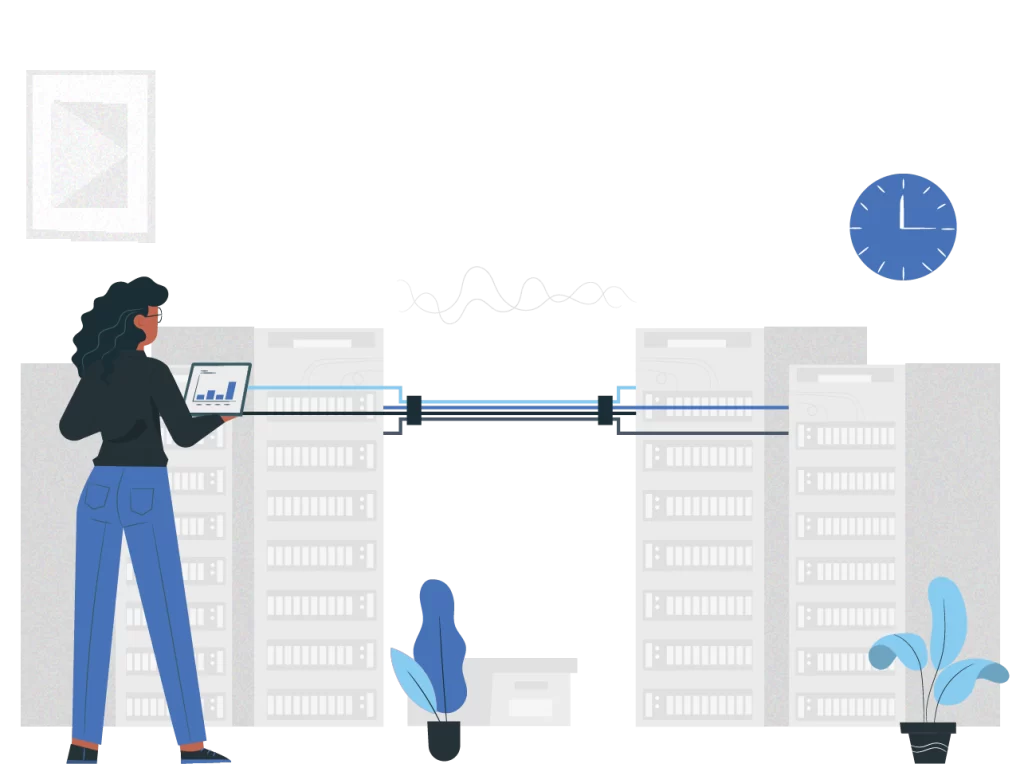In the dynamic landscape of modern business, the significance of an enterprise network cannot be overstated. This foundational infrastructure serves as the lifeblood of organizations, enabling seamless communication, data exchange, and collaboration across various departments and locations. With the increasing reliance on digital solutions and remote work, the role of an effective enterprise network has evolved into a critical driver of operational efficiency, innovation, and business growth.
From facilitating secure and high-speed data transmission to supporting cloud-based applications and enabling remote access, an optimized enterprise network lays the groundwork for success in the digital age. This article delves into the multifaceted role of the enterprise network, exploring how it empowers businesses to stay connected, competitive, and adaptable in an ever-evolving landscape. By understanding the pivotal role that an enterprise network plays, organizations can harness its potential to drive strategic initiatives and achieve their goals with precision and agility.
An Overview
In the intricate web of modern business operations, the concept of an enterprise network emerges as a cornerstone of connectivity and collaboration. This first section provides a comprehensive glimpse into the essence and significance of an enterprise network, highlighting its pivotal role in enabling seamless communication, facilitating data exchange, and fostering a cohesive digital ecosystem. By delving into the fundamental aspects of an enterprise network, readers can uncover the driving forces that empower organizations to thrive in the dynamic landscape of the digital age.
What is an enterprise network?
At its core, an enterprise network serves as the digital framework that connects an organization’s various devices, systems, and applications into a cohesive and efficient ecosystem. It functions as a complex web of interconnected components, enabling seamless communication and data exchange among employees, departments, and even external partners. An enterprise network acts as the lifeline through which information flows, enabling tasks to be accomplished, decisions to be made, and innovations to be realized.
In essence, an enterprise network is the technology-driven bloodstream that fuels the operations of modern businesses. It encompasses wired and wireless connections, routers, switches, servers, and other critical infrastructure components. This network architecture can span across physical locations, connecting branch offices, remote workers, and data centers into a unified environment.
The significance of an enterprise network extends beyond mere connectivity. It facilitates collaborative work, supports the utilization of cloud-based applications, and ensures the secure transfer of sensitive information. As businesses increasingly embrace digital transformation, an optimized enterprise network becomes a strategic asset that empowers organizations to adapt, compete, and succeed in the rapidly evolving business landscape.
The importance of enterprise networks
Enterprise networks emerge as pivotal enablers of efficiency, collaboration, and growth. These networks facilitate seamless communication among employees, departments, and different locations, fostering a cohesive and productive environment. According to Statista Research Department, the dominance of industry leaders like Cisco Systems, comprising 41 percent of the enterprise network infrastructure market, highlights the critical role of enterprise networks in the global market.

Notably, the global enterprise network infrastructure market has witnessed substantial growth, exemplified by the forecasted worth of 20.5 billion U.S. dollars in 2017 for the layer 2 and layer 3 switches. This escalating market underscores the rising recognition of the enterprise network as an essential investment for businesses aiming to enhance operational efficiency, adaptability, and competitiveness. As enterprises navigate the digital landscape, enterprise networks emerge as strategic assets, driving innovation and positioning organizations for sustained success.
Recommended reading: Data Center Migration Strategy: Lessons from 5 Real-Life Cases
3 Benefits of a Robust Enterprise Network
This section explores the invaluable advantages that a strong enterprise network brings to the table, illustrating how it empowers seamless communication, enhances operational efficiency, and paves the way for strategic innovation. By delving into these benefits, readers can grasp the pivotal role that a robust enterprise network plays in driving businesses to new heights of excellence and competitiveness.
Seamless communication and collaboration
At the heart of a robust enterprise network lies the power to foster seamless communication and collaboration among employees, departments, and diverse locations. By eradicating geographical barriers and bridging time zones, an efficient enterprise network ensures that teams remain interconnected and engaged in real-time exchanges of information and ideas. This connectivity fuels synergy, enabling teams to collaboratively address challenges, devise innovative solutions, and streamline decision-making processes.
Through instant messaging, video conferencing, and shared document repositories, a well-structured enterprise network empowers individuals to effortlessly exchange insights, share feedback, and co-create irrespective of their physical location. This dynamic flow of communication enhances responsiveness, accelerates project timelines, and cultivates a culture of transparency and inclusivity. As a result, businesses can harness the full potential of their talent pool, driving productivity, agility, and cohesion in today’s fast-paced corporate landscape.
Support for remote work and cloud applications
These days where remote work and cloud-based applications are becoming the norm, a robust enterprise network plays a pivotal role in enabling seamless access to resources from any location. With the emergence of virtual work environments, a well-structured enterprise network ensures that remote employees can securely connect to the organization’s infrastructure, applications, and databases. This accessibility not only enhances productivity but also fosters a work-life balance by granting employees the flexibility to work from their preferred locations.
Furthermore, a strong enterprise network acts as a bridge to cloud-based applications and services. Whether it’s data storage, customer relationship management, or project management tools, an optimized network allows businesses to efficiently deploy and manage cloud solutions. This integration empowers companies to scale their operations, streamline workflows, and adapt swiftly to changing market dynamics.
By providing a seamless connection between remote workers and cloud resources, an adept enterprise network supports a dynamic and agile work environment, amplifying efficiency, innovation, and business continuity.
Enhanced data security and privacy
A robust enterprise network serves as a formidable defense against potential cyber threats and unauthorized access to sensitive information. By implementing advanced security protocols and encryption mechanisms, businesses can shield their data from breaches, ensuring the confidentiality and integrity of critical assets.

A well-designed enterprise network enables the establishment of secure access controls, limiting user permissions and granting authorized personnel the appropriate levels of data access. This ensures that sensitive information is only available to those with legitimate needs, reducing the risk of data leaks or misuse.
Furthermore, a fortified enterprise network aids in compliance with stringent data protection regulations, such as GDPR or HIPAA. By tracking and monitoring data flows, businesses can demonstrate their commitment to safeguarding customer and employee data, thereby fostering trust and loyalty.
Ultimately, the robust security features of an adept enterprise network create a resilient fortress against cyber threats, bolstering data privacy and reinforcing the reputation of the organization as a reliable custodian of confidential information.
Recommended reading: A Guide to Effective Cloud Orchestration
3 Key Components of an Effective Enterprise Network
An efficient and robust enterprise network is the backbone of modern business operations, facilitating seamless communication, secure data transfer, and streamlined workflows. To achieve these functionalities, an effective enterprise network comprises several key components meticulously designed to meet the demands of a dynamic and interconnected business landscape. In this section, we delve into the essential building blocks that form the foundation of a successful enterprise network, enabling businesses to thrive in the digital age.
Network infrastructure and architecture
The network infrastructure and architecture of an enterprise network serve as its foundational structure, determining how data flows, devices connect, and communication happens. A well-designed enterprise network architecture ensures efficient data transmission, minimizes latency, and supports scalability as the business grows. The architecture involves the arrangement of routers, switches, firewalls, load balancers, and other network devices, strategically positioned to optimize traffic flow and provide redundancy for high availability.
With the increasing demand for cloud services and remote access, modern enterprise networks often incorporate hybrid and software-defined architectures, allowing seamless integration between on-premises infrastructure and cloud resources. These architectural choices play a pivotal role in ensuring network agility, security, and adaptability to evolving business needs.
A well-structured enterprise network architecture also contributes to cybersecurity by segmenting different parts of the network, thus containing potential breaches and limiting their impact. It empowers businesses to implement access controls, intrusion detection systems, and encryption mechanisms, safeguarding sensitive data from unauthorized access.
To build a resilient and future-ready enterprise network, organizations must collaborate with network architects and engineers to design an architecture that aligns with their unique operational requirements. This strategic approach enables businesses to harness the full potential of their enterprise network to foster growth, innovation, and competitive advantage in the digital landscape.
Scalability and flexibility
One of the critical components of an effective enterprise network is its scalability and flexibility, allowing businesses to respond to evolving demands and growth opportunities. In today’s dynamic business environment, where expansion, new applications, and changing user needs are constant, a network that can seamlessly accommodate these changes is invaluable.
Enterprise networks need to be designed with scalability in mind, ensuring that they can handle increased traffic, users, and data without compromising performance. Scalability enables businesses to add new devices, applications, and services to the network without causing bottlenecks or downtime. Whether it’s accommodating new remote workers or integrating IoT devices, a scalable network architecture ensures smooth operations.
Flexibility complements scalability by providing the agility to adapt to changing business requirements. A flexible enterprise network can be easily reconfigured, allowing businesses to optimize their network resources for different purposes. It also enables the adoption of emerging technologies, such as cloud computing, edge computing, and virtualization, without major disruptions.
The cloud plays a crucial role in enhancing scalability and flexibility. Cloud-based solutions allow businesses to scale their network resources on-demand, adjusting to peak usage periods or sudden changes in demand. Additionally, cloud services provide a level of flexibility that was previously unattainable, enabling remote access, collaboration, and application deployment from anywhere with an internet connection.
To ensure the scalability and flexibility of their enterprise network, organizations should invest in modern networking technologies that support virtualization, software-defined networking (SDN), and network automation. These technologies empower businesses to adapt quickly to market changes and embrace innovation while maintaining a reliable and efficient network infrastructure.
Network monitoring and management tools
Effective enterprise networks rely on robust network monitoring and management tools to ensure optimal performance, troubleshoot issues, and proactively address potential disruptions. In today’s interconnected business landscape, where downtime and network outages can lead to significant losses, these tools play a vital role in maintaining network health and reliability.

Network monitoring tools provide real-time visibility into the performance of the enterprise network, allowing IT teams to monitor traffic, bandwidth utilization, latency, and other key metrics. By continuously analyzing network data, these tools can identify anomalies, bottlenecks, and potential security threats. With this information, IT professionals can take proactive measures to prevent performance degradation and mitigate risks.
These tools also assist in diagnosing and resolving network issues swiftly. When problems arise, network administrators can use monitoring data to pinpoint the root causes of the issues and implement appropriate solutions. This minimizes downtime and ensures that the network remains responsive and accessible to users.
Network management tools go beyond monitoring and offer capabilities for configuration, optimization, and automation. They allow administrators to manage network devices, apply updates, and enforce security policies across the enterprise network. Automation features streamline repetitive tasks, reducing the risk of human error and freeing up IT resources for more strategic initiatives.
Cloud-based network management solutions have gained popularity due to their flexibility and ease of deployment. These platforms enable administrators to manage enterprise networks across multiple locations from a centralized dashboard. They provide a holistic view of network performance, simplify configuration changes, and enable rapid deployment of new services and applications.
FURTHER READING: |
1.Virtual Machine Host 101: Everything You Need to Know |
2.How to Choose a Web Hosting Provider That Meets Your Needs |
3. How Virtualized Infrastructure Transforms IT Operations |
Leverage 1Byte’s strong cloud computing expertise to boost your business in a big way
1Byte provides complete domain registration services that include dedicated support staff, educated customer care, reasonable costs, as well as a domain price search tool.
Elevate your online security with 1Byte's SSL Service. Unparalleled protection, seamless integration, and peace of mind for your digital journey.
No matter the cloud server package you pick, you can rely on 1Byte for dependability, privacy, security, and a stress-free experience that is essential for successful businesses.
Choosing us as your shared hosting provider allows you to get excellent value for your money while enjoying the same level of quality and functionality as more expensive options.
Through highly flexible programs, 1Byte's cutting-edge cloud hosting gives great solutions to small and medium-sized businesses faster, more securely, and at reduced costs.
Stay ahead of the competition with 1Byte's innovative WordPress hosting services. Our feature-rich plans and unmatched reliability ensure your website stands out and delivers an unforgettable user experience.
As an official AWS Partner, one of our primary responsibilities is to assist businesses in modernizing their operations and make the most of their journeys to the cloud with AWS.
Conclusion
The evolving landscape of technology demands that enterprise networks be agile, secure, and adaptable. The interconnectedness of devices, the rise of remote work, and the proliferation of data-intensive applications underscore the importance of a robust network infrastructure. Businesses must invest in the right components, from network architecture to monitoring tools, to ensure consistent performance and reliability.
With the right enterprise network in place, organizations can achieve significant benefits, including enhanced communication, streamlined operations, and improved data security. Furthermore, the role of network monitoring and management tools cannot be overstated—they empower IT teams to proactively address challenges and maintain a high level of network availability.
As the business landscape continues to evolve, the role of the enterprise network will remain central to success. By staying informed about the latest advancements and best practices in network design, deployment, and management, organizations can leverage their enterprise networks as strategic assets that propel them toward growth and innovation. In a world driven by connectivity, the right network can be a catalyst for achieving business objectives and staying ahead in the competitive landscape.

